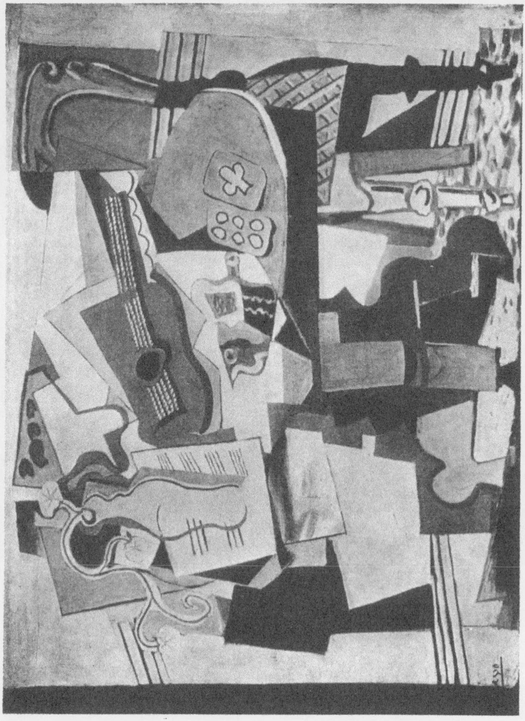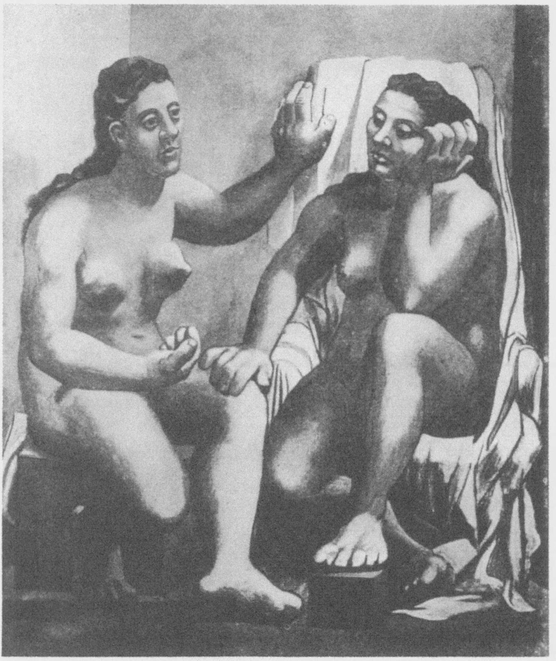It had a great success, it was produced and accepted, of course, from the moment it was put on the stage, of course, it was accepted.
So the great war continued but it was nearing its end, and the war of cubism, it too was commencing to end, no war is ever ended, of course not, it only has the appearance of stopping. So Picasso’s struggle continued but for the moment it appeared to have been won by himself for himself and by him for the world.
It is an extraordinary thing but it is true, wars are only a means of publicising the things already accomplished, a change, a complete change, has come about, people no longer think as they were thinking but no one knows it, no one recognises it, no one really knows it except the creators. The others are too busy with the business of life, they cannot feel what has happened, but the creator, the real creator, does nothing, he is not concerned with the activity of existing, and as he is not active, that is to say as he is not concerned with the activity of existence he is sensitive enough to understand how people are thinking, he is not interested in knowing how they were thinking, his sensitive feeling is concerned in understanding how people live as they are living. The spirit of everybody is changed, of a whole people is changed, but mostly nobody knows it and a war forces them to recognise it because during a war the appearance of everything changes very much quicker, but really the entire change has been accomplished and the war is only something which forces everybody to recognise it. The French revolution was over when war forced everybody to recognise it, the American revolution was accomplished before the war, the war is only a publicity agent which makes every one know what has happened, yes, it is that.
So then the public recognises a creator who has seen the change which has been accomplished before a war and which has been expressed by the war, and by the war the world is forced to recognise the entire change in everything, they are forced to look at the creator who, before any one, knew it and expressed it. A creator is not in advance of his generation but he is the first of his contemporaries to be conscious of what is happening to his generation.
A creator who creates, who is not an academician, who is not some one who studies in a school where the rules are already known, and of course being known they no longer exist, a creator then who creates is necessarily of his generation. His generation lives in its contemporary way but they only live in it. In art, in literature, in the theatre, in short in everything that does not contribute to their immediate comfort they live in the preceding generation. It is very simple, to-day in the streets of Paris, horses, even tramcars can no longer exist but horses and tramcars are only suppressed only when they cause too many complications, they are suppressed but sixty years too late. Lord Grey said when the war broke out that the generals thought of a war of the nineteenth century even when the instruments of war were of the twentieth century and only when the war was at its heighth did the generals understand that it was a war of the twentieth century and not a war of the nineteenth century. That is what the academic spirit is, it is not contemporary, of course not, and so it can not be creative because the only thing that is creative in a creator is the contemporary thing. Of course.

35 STILL-LIFE WITH VIOLIN (1920)

36 TWO NUDES WITH DRAPERY (1920)
As I was saying, in the daily living it is another thing. A friend built a modern house and he suggested that Picasso too should have one built. But, said Picasso, of course not, I want an old house. Imagine, he said, if Michael Angelo would have been pleased if some one had given him a fine piece of Renaissance furniture, not at all. He would have been pleased if he had been given a beautiful Greek intaglio, of course.
So that is the way it is, a creator is so completely contemporary that he has the appearance of being ahead of his generation and to calm himself in his daily living he wishes to live with the things in the daily life of the past, he does not wish to live as contemporary as the contemporaries who do not poignantly feel being contemporary. This sounds complicated but it is very simple.
So when the contemporaries were forced by the war to recognise cubism, cubism as it had been created by Picasso who saw a reality that was not the vision of the nineteenth century, which was not a thing seen but felt, which was a thing that was not based upon nature but opposed to nature like the houses in Spain are opposed to the landscape, like the round is opposed to cubes. Every one was forced by the war which made them understand that things had changed to other things and that they had not stayed the same things, they were forced then to accept Picasso. Picasso returned from Italy and freed by Parade, which he had just created, he became a realistic painter, he even made many portraits from models, portraits which were purely realistic. It is evident that really nothing changes but at the same time everything changes and Italy and Parade and the termination of the war gave to Picasso in a kind of a way another harlequin period, a realistic period, not sad, less young, if you like, but a period of calm, he was satisfied to see things as everybody saw them, not completely as everybody does but completely enough. Period of 1917 to 1920.
Picasso was always possessed by the necessity of emptying himself, of emptying himself completely, of always emptying himself, he is so full of it that all his existence is the repetition of a complete emptying, he must empty himself, he can never empty himself of being Spanish, but he can empty himself of what he has created. So every one says that he changes but really it is not that, he empties himself and the moment he has completed emptying himself he must recommence emptying himself, he fills himself up again so quickly.
Twice in his life he almost emptied himself of being Spanish, the first time during his first real contact with Paris when there came the harlequin or rose period, 1904— 1906, the second time was his contact with the theatre, that was the realistic period which lasted from 1918 to 1921. During this period he painted some very beautiful portraits, some paintings and some drawings of harlequins and many other pictures. This adult rose period lasted almost three years.
But of course the rose period could not persist in him. He emptied himself of the rose period and inevitably it changed to something else, this time it changed to the period of large women and later to one of classic subjects, women with draperies, perhaps this was the commencement of the end of this adult rose period.
There certainly have been two rose periods in the life of Picasso. During the second rose period there was almost no real cubism but there was painting which was writing which had to do with the Spanish character, that is to say the Saracen character and this commenced to develop very much.
I will explain.
In the Orient calligraphy and the art of painting and sculpture have always been very nearly related, they resemble each other, they help each other, they complete each other. Saracen architecture was decorated with letters, with words in Sanskrit letters, in China the letters were something in themselves. But in Europe the art of calligraphy was always a minor art, decorated by painting, decorated by lines, but the art of writing and the decoration by writing and the decoration around writing are always a minor art. But for Picasso, a Spaniard, the art of writing, that is to say calligraphy, is an art. After all the Spaniards and the Russians are the only Europeans who are really a little Oriental and this shows in the art of Picasso, not as anything exotic but as something quite profound.
1 comment